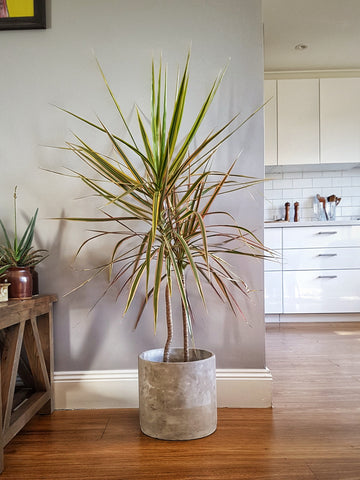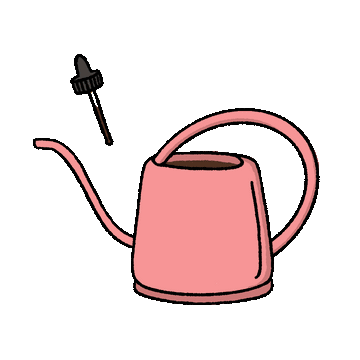This week's blog is focusing on air purifying plants. We're often asked for recommendations by our customers and thought it high time to get the list online.
When talking air purifying plants, people can't resist bring up NASA.
90% of plant blogs will mention it: "...according to NASA scientists..." or "...a study commissioned by NASA said...".
This is wonderful, but also easy to take out of context.
In the late 80's, NASA looked at the ability of houseplants to remove 'volatile organic compounds' (VOCs) from the air. VOCs are basically emitted by anything that has a scent - think house-paint, shampoo, nail polish - and can have a range of different harmful effects on us. Something as mild as an itchy throat right up to nasopharyngeal cancer.
Basically, VOCs are not good. They can't be filtered out of the air by fine filters and they are especially bad to have lingering around in a an air-tight laboratory or spacecraft...hence the study.
The report concluded that plants were “a promising, economical solution to indoor air pollution,". Great!
Truth is though, this was a study based around laboratory conditions. Our homes are a whole other kettle of fish and even the most powerful air purifying plant probably isn't going to make as much of an impact as that NASA study might suggest. To really make an impact on your air quality, you need to think about the size of the room and the size of the plant.
According to a recent report by Plant Life Balance, you need at least 5 medium plants (.6m - 1.2m tall) or 15 small plants (under .6m) in a 4x5m room to improve the air quality by 75%. In a large room (8x8m) we're talking 16 plants.
Chances are, if you're reading this blog, being told "get more plants" isn't really a bad thing. So we've come up with this list of the 10 best air purifying plants to help you achieve your air quality goals.
1. Snake Plant (Sansevieria spp.)
Stylish, long-living, hardy, low maintenance and a heap of variety - there's alot to like about these guys. Throw in a few facts about their air-purifying ability (they remove formaldehyde, xylene, toluene, and nitrogen oxides from the air) and the fact that they are one of the few plants that covert carbon dioxide (CO2) to oxygen AT NIGHT (so great for the bedroom!)...well, they're just a rad plant.
Snake Plants can tolerate a decent amount of direct sunlight as well as suffering through low light placement with no complaints. Ideally, they'd like a bright room with plenty of indirect sunlight but part of their charm is that they can still tolerate both ends of the light spectrum. Water every 2-3 weeks and even less over winter.

2. Rubber Plant (Ficus Elastica)
If you needed another reason to love these guys - you found it. The Rubber Plant is #1 against formaldehyde, as well as removing xylene, benzene, and trichloroethylene from the air. Need me to hype them more? With a variety of colours (ruby, burgundy, deep green to speckled yellow) and glossy foliage that nearly always looks good, the Rubber Plant is the tolerant, classy cousin to the fussy Fiddle Leaf Fig.
Rubber Plants are happy in bright, filtered light. Water when the top few centimetres of the potting mix is dry. Feed monthly with a quality liquid fertiliser and wipe down the leaves with neem oil on a monthly basis to keep them dust free.

3. Flamingo Lily (Anthurium andraeanum)
We've covered our Aroid Addiction in a previous post, so we had to include the air-purifying Flamingo Lily on this list. Grown for their gorgeous pink bracts (a modified leaf that acts as a sheath around the spadix), they are an incredible indoor plant to add to your home if you're also looking for a pop of colour. They are most effective at removing chemicals like ammonia and formaldehyde.
Anthuriums like bright indirect light, humid conditions and to be kept in slightly moist potting media. Watering 1-2 times a week.

4. Bamboo Palm (Chamaedorea seifrizii)
When your focus is on air purification, it's all about leaf surface area. The more leaf there is the the more purifying the plant can be. So it should be no surprise that the Bamboo Palm is an absolute purifying machine. They grow up to 3.5m, are pet friendly and can handle a bit of direct sunlight (although bright filtered light is preferred).
Definitely a statement plant. The Bamboo Palm filters formaldehyde, trichloroethylene and benzene. They like well draining potting mix and benefit from occasional pruning of brown leaves.
5. Spider Plant (Chlorophytum comosum)
One for the plant killers! These plants are great hanging or trailing plants as they send out shoot with baby 'spiders' that spill out over the edge of planters looking for somewhere to plant their roots and get growing. Tough as nails, they can survive in full sun, part shade and very cold temperatures. Also, they're great at filtering formaldehyde and xylene. Win!
Likes to be watered regularly and fed monthly over Spring and Summer.

6. Peace Lily (Spathiphyllum spp.)
You need it filtered? Peace Lillies will probably do it. These low maintenance houseplants will filter benzene, carbon monoxide, formaldehyde, trichloroethylene, xylene from the room. They're great low light plants and an awesome choice for indoor plant newcomers.
Peace Lilies will perform best in bright spaces out of the way of any direct sunlight. They don't like dry air so try to keep humid or group with other plants to keep the humidity levels raised. They will benefit greatly from regular feeding too.

7. Devil's Ivy (Epipremnum aureum)
That's right, Devil's Ivy has made yet another list. Cascading tendrils, tough as nails, almost impossible to kill. Low light, bright light...whatever you throw at it (bar direct sunlight), the Devil's Ivy will take it in its stride. As far as the VOCs go...xylene, benzene, formaldehyde and trichloroethylene are all filtered.
Ideally, Epipremnum plants prefer nice bright space without any direct sunlight. Water when the top few centimetres of potting mix is dry to the touch and feed monthly while the plant is actively growing.

8. Draceana (Dracaena spp.)
Love 'em or hate 'em - they've made the list because they handle xylene, trichloroethylene, and formaldehyde. Often a polarising plant, their architectural habit is definitely not for everyone, although we're huge fans of the gnarly, woody stems.
They thrive in medium to bright light, and should be watered whenever the surface of the potting mix gets dry. They can be susceptible to root rot though so reduce watering over winter.

9. Aloe Vera (Aloe spp.)
Aloe Aloe! (Can't let a good pun go by!)
Aloe filters formaldehyde and also has some wonderful inflammatory properties. If you're vulnerable to a little sunburn like me, they're great to have on hand.
Keep in bright light (direct sunlight is fine) and water only when the potting medium has dried out.

10. Lady Palm (Raphis excelsa)
These slow growing palms are a great plant to have in cooler rooms as they prefer temperatures around 15-20 degrees. They filter formaldehyde, ammonia and xylene and look incredible.
Raphis Palms prefer indirect light and being kept slightly moist when possible. Because of their slow growth rate, they are susceptible to over fertilising and should be fed at half strength and only in Summer.




Leave a comment